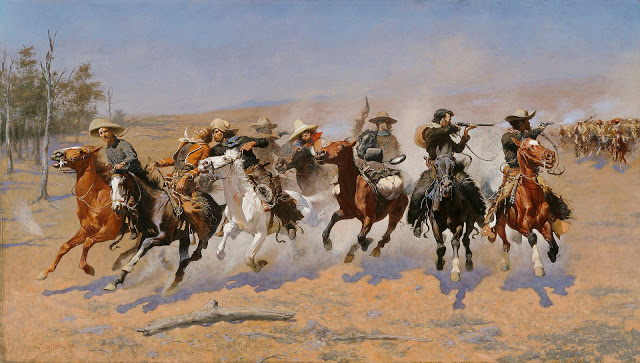 |
| Dash for the Timberline 1889 |
My drawing is done entirely from memory. I never use a camera now. The interesting never occurs in nature as a whole, but in pieces. It’s more what I leave out than what I add.
-F. Remington
Those of you in the New York area only have less than a month to get to the Metropolitan Museum of Art to see the exhibit of the famous American western artists, Frederick Remington.
If the idea of Old Wild West is a story, then Frederick Remington is the illustrator of that story.
As America exited the Civil War and began to expand westward in the second half of 19th century young Frederick Remington (1861-1909) was the heir to the Remington Arms company which had made his family a fortune during the war. Frederick grew up in New York and attended Yale University Art School in Connecticut, decidedly not the frontiersman of the wild west.
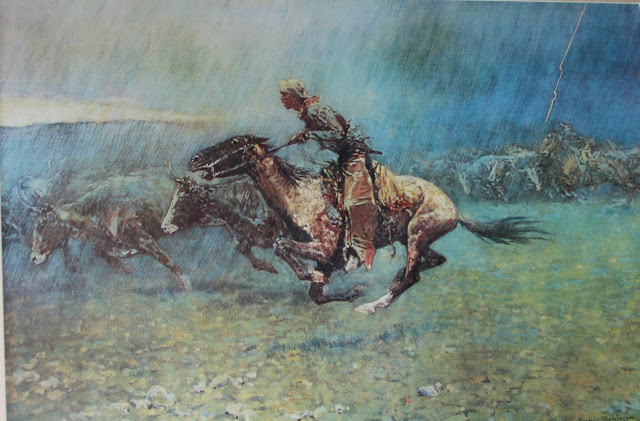 |
| Stampede 1908 |
After the death of his father Remington dropped out of Yale and, and began traveling on his family’s fortune, and ended up in 1880’s in the frontier of the American West. Following the buffalo herds, listening to the stories of the trappers and the ranchers and the Native American tribes that were being moved to new reservations he became deeply enamored with the mythology and beauty of the lifestyle of the frontier sketching and painting the world he saw trying to capture this disappearing landscape for posterity. In 1886 Frederick returned to New YorkCity, enrolled at the Art Students League to sharpen his unfinished art school training, and to become a professional artist and illustrator in the new booking publishing world, hungry for tales and pictures of the”Wild West”.
By 1890 Remington’s exciting and authentic paintings and drawings of the West had become extremely well received capturing the drama and excitement of the West, and he and his new family move to the suburbs of Manhattan in New Rochelle to set up home and studio. That same year In 1890 ironically, the American Secretary of the Census declared the American Frontier Closed. Three years later at The Columbian Exhibition in Chicago it was said: “…the conquest of the western frontier as the nation’s formative experience, which had shaped the nation’s character and values. Western expansion accounted for Americans’ optimism, their rugged independence, and their stress on adaptability, ingenuity, and self reliance.”
 |
| Lone Wolf 1909 |
By the 1890’s Remington’s style had gone out of style and he had difficulty getting work into the Academy, was bored by illustration jobs and was dropped by Harpers in 1900. Remington famously burned a large portion of his work in a bonfire in disgust. This lull allowed the artist to pursue bronze sculpture, writing and the running of the family business until his death.
Remington had been the last of the real western artists of the American frontier and captured a pathos and history of not just the settlers but also the native people who lived, worked and died in that land. Later artists like NC Wyeth would follow in the footsteps of Remington but the West was gone, and just the legend remained.
The inclusion of a retrospective gallery exhibition at The Metropolitan Museum demonstrates a paradigm shift in what contemporary curators of Museums are considering influential in American Art history. Just a generation ago works by Remington and his contemporaries were almost nowhere to be seen in the major museums, today they often hold central pride of place in their galleries. Additionally, alongside works by “academic” artists like Remington museums have begun to juxtapose native American pottery and textile work along side frontier folk-art. This wider view gives a better perspective to the period that was so transformative and controversial in the history of America.
From: The Metropolitan Museum of Art
Exhibition Overview
The legacy of the enduringly popular American artist Frederic Remington (1861–1909), chronicler par excellence of the American West, is presented through some 20 paintings, sculptures, works on paper, and illustrated books from the late 1880s until his death. Although he lived and worked on the East Coast, Remington traveled extensively. His insightful depictions of trappers, Native Americans, cavalry, scouts, and, above all, his archetypal cowboys are some of the most iconic images of the Old West.
A Gallery of Frederick Remington Works:
 |
| Dash for the Timberline 1889 |
My drawing is done entirely from memory. I never use a camera now. The interesting never occurs in nature as a whole, but in pieces. It’s more what I leave out than what I add.
-F. Remington
Those of you in the New York area only have less than a month to get to the Metropolitan Museum of Art to see the exhibit of the famous American western artists, Frederick Remington.
If the idea of Old Wild West is a story, then Frederick Remington is the illustrator of that story.
As America exited the Civil War and began to expand westward in the second half of 19th century young Frederick Remington (1861-1909) was the heir to the Remington Arms company which had made his family a fortune during the war. Frederick grew up in New York and attended Yale University Art School in Connecticut, decidedly not the frontiersman of the wild west.
 |
| Stampede 1908 |
After the death of his father Remington dropped out of Yale and, and began traveling on his family’s fortune, and ended up in 1880’s in the frontier of the American West. Following the buffalo herds, listening to the stories of the trappers and the ranchers and the Native American tribes that were being moved to new reservations he became deeply enamored with the mythology and beauty of the lifestyle of the frontier sketching and painting the world he saw trying to capture this disappearing landscape for posterity. In 1886 Frederick returned to New YorkCity, enrolled at the Art Students League to sharpen his unfinished art school training, and to become a professional artist and illustrator in the new booking publishing world, hungry for tales and pictures of the”Wild West”.
By 1890 Remington’s exciting and authentic paintings and drawings of the West had become extremely well received capturing the drama and excitement of the West, and he and his new family move to the suburbs of Manhattan in New Rochelle to set up home and studio. That same year In 1890 ironically, the American Secretary of the Census declared the American Frontier Closed. Three years later at The Columbian Exhibition in Chicago it was said: “…the conquest of the western frontier as the nation’s formative experience, which had shaped the nation’s character and values. Western expansion accounted for Americans’ optimism, their rugged independence, and their stress on adaptability, ingenuity, and self reliance.”
 |
| Lone Wolf 1909 |
By the 1890’s Remington’s style had gone out of style and he had difficulty getting work into the Academy, was bored by illustration jobs and was dropped by Harpers in 1900. Remington famously burned a large portion of his work in a bonfire in disgust. This lull allowed the artist to pursue bronze sculpture, writing and the running of the family business until his death.
Remington had been the last of the real western artists of the American frontier and captured a pathos and history of not just the settlers but also the native people who lived, worked and died in that land. Later artists like NC Wyeth would follow in the footsteps of Remington but the West was gone, and just the legend remained.
The inclusion of a retrospective gallery exhibition at The Metropolitan Museum demonstrates a paradigm shift in what contemporary curators of Museums are considering influential in American Art history. Just a generation ago works by Remington and his contemporaries were almost nowhere to be seen in the major museums, today they often hold central pride of place in their galleries. Additionally, alongside works by “academic” artists like Remington museums have begun to juxtapose native American pottery and textile work along side frontier folk-art. This wider view gives a better perspective to the period that was so transformative and controversial in the history of America.
From: The Metropolitan Museum of Art
Exhibition Overview
The legacy of the enduringly popular American artist Frederic Remington (1861–1909), chronicler par excellence of the American West, is presented through some 20 paintings, sculptures, works on paper, and illustrated books from the late 1880s until his death. Although he lived and worked on the East Coast, Remington traveled extensively. His insightful depictions of trappers, Native Americans, cavalry, scouts, and, above all, his archetypal cowboys are some of the most iconic images of the Old West.
A Gallery of Frederick Remington Works:


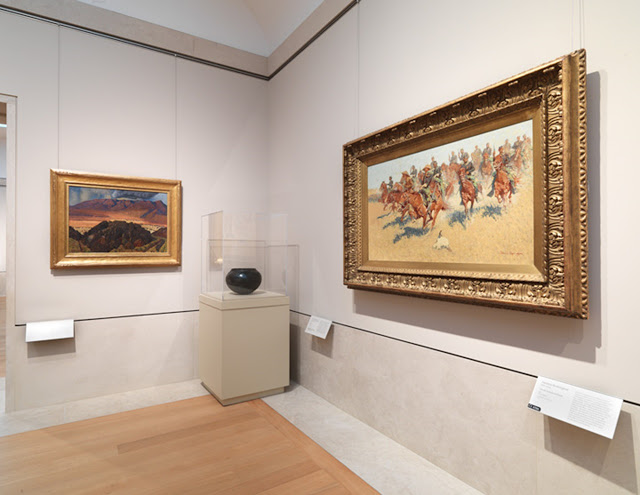
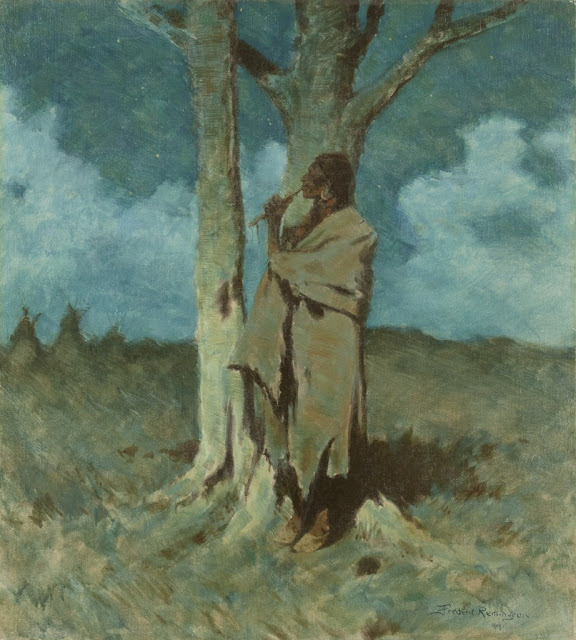
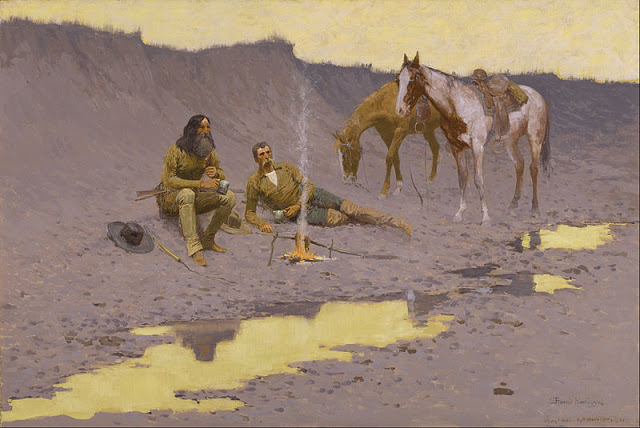
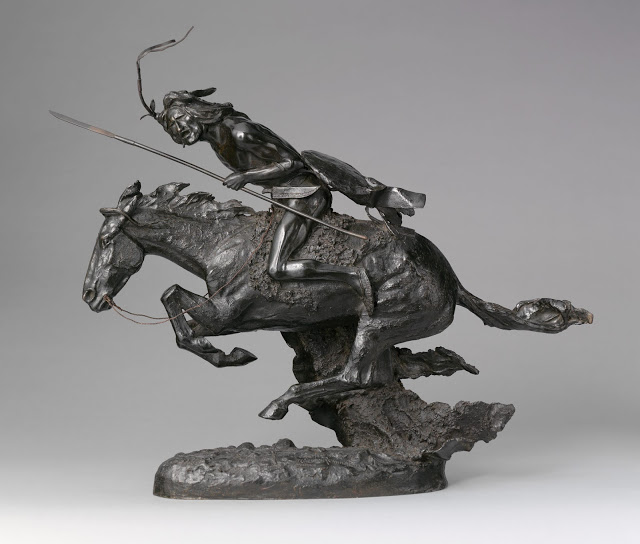
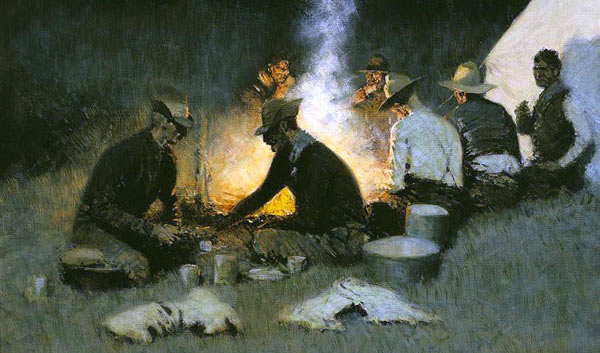

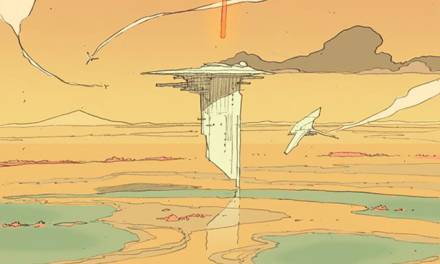

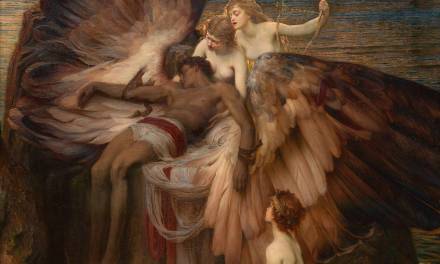


Recent Comments